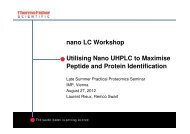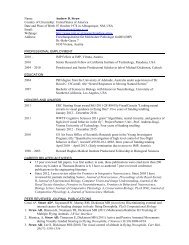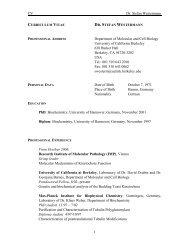IMP Research Report 2002
IMP Research Report 2002
IMP Research Report 2002
You also want an ePaper? Increase the reach of your titles
YUMPU automatically turns print PDFs into web optimized ePapers that Google loves.
Figure 1: Crossing the midline. In the Drosophila CNS, some axons cross the midline (like the red axons in A), but others do not (B). Those that do<br />
cross, called commissural axons, cross only once. Comm functions as a switch to control this decision (C). Comm is ON in commissural neurons as<br />
they cross, but OFF in ipsilateral neurons and post-crossing commissural neurons. Comm regulates the sensitivity of axons to the midline repellent Slit<br />
(yellow in C). It does this by controlling the intracellular trafficking of Robo (blue), the Slit receptor.<br />
specific layer of the brain. We continue to look for the<br />
remaining genes, and are beginning to piece together<br />
the molecular pathways and processes that underlie<br />
this exceptional example of neuronal engineering.<br />
grow toward and across the midline. If it is made<br />
inactive (by a mutation), no axon can cross the midline,<br />
resulting in the commissureless phenotype from which<br />
the gene got its name. In ipsilateral neurons, and postcrossing<br />
commissural neurons, Comm is normally<br />
inactive. But by activating Comm in these neurons, we<br />
can force them to cross (or recross). This defines Comm<br />
as a simple genetic switch to control midline crossing<br />
(Figure 1). We are currently trying to find out how this<br />
switch is turned ON and OFF, and how Comm selects<br />
Robo and sorts it to lysosomes.<br />
Axon guidance in the visual system<br />
Flies have excellent vision. This rests in part on the<br />
extraordinarily precise connections established<br />
between photoreceptors in the eye and their targets in<br />
the brain. As a first step in determining how these<br />
connections are established, we screened though more<br />
than 32,000 mutant lines to find some 200 mutants with<br />
Figure 2: Photoreceptor axon targeting. Photoreceptor axons<br />
(green) extend from the eye disc, through the optic stalk, and into<br />
the optic lobe. Some axons terminate in the lamina (arrow). Others,<br />
including R8 axons, terminate in the medulla (arrowhead), where<br />
they form synapses with medulla neurons (red). The Flamingo<br />
protein (blue) is required for correct targeting of R8 axons.<br />
abnormal connectivity patterns. These mutations define<br />
about 50 different genes, 31 of which we have now<br />
identified. These genes encode cell surface receptors<br />
Contact: dickson@imp.univie.ac.at<br />
and signaling molecules, as well as factors involved in<br />
gene transcription, axonal transport, and membrane<br />
trafficking. One of them encodes a 7-transmembrane<br />
cadherin called Flamingo. Flamingo is expressed on<br />
many different photoreceptor axons and their target cells<br />
in the brain (Figure 2). It is needed for one class of<br />
photoreceptors (R8s) to select their correct targets in a<br />
17
















